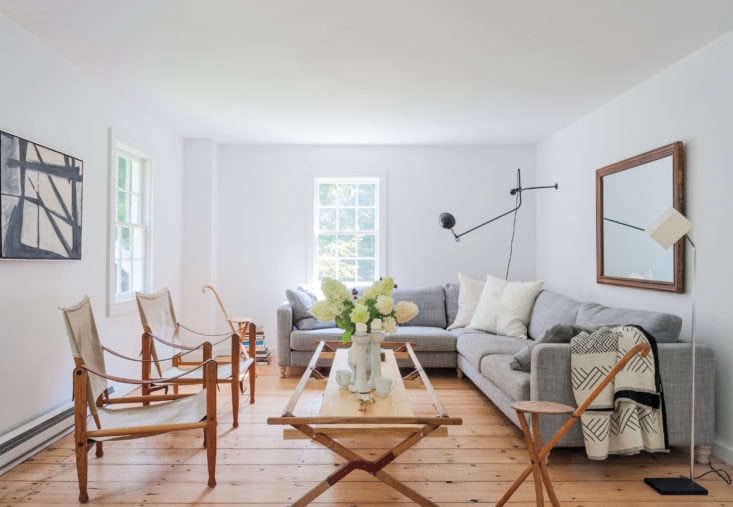Don’t let a small room cramp your style! Smaller spaces actually have their perks – they’re easier to decorate, clean, and keep organized.
Ready to make your room look bigger?
Focus on easy fixes: clear out clutter, add mirrors or other reflective items, and choose light, neutral colors.
Read on for more simple, cost-effective strategies to maximize your small space.
Clear Clutter
:max_bytes(150000):strip_icc():format(webp)/Gibbs-Ave-103-5e22f04627154e38a7d0ff0681ce6c72.jpg)
There’s nothing that makes a small space feel more cramped than having too much stuff.
Work out ways to get collections out of view, organized behind doors, table skirts, or on shelves.
With things neatly arranged and out of sight, the space that is in view will feel orderly and open.
Keep Pathways Clear
:max_bytes(150000):strip_icc():format(webp)/make-a-small-room-look-bigger-1976069-02-0e0f7e77429647b78014b8e4d79dcece.jpg)
When furniture and accessories block the view into a room, it will look cramped. By moving furniture out and away from walkways, you’ll open up the space and make it feel larger.
You can also choose low-profile pieces of furniture like an ottoman, an armless open chair, or a low table, and place large, tall pieces along a wall rather than out in the open space.
If you can see the floor, the room will look larger.
Choose Soft, Light Colors
:max_bytes(150000):strip_icc():format(webp)/MaryPatton_Septmeber2021-10-966d759fa8d74a2ab0bef9787f911051.jpg)
Whereas dark, warm colors make space feel cozy and intimate, light, cool colors make space feel open and airy.
For optimum effect, select soft tones of blue and green.
Use a Neutral Color Scheme
:max_bytes(150000):strip_icc():format(webp)/make-a-small-room-look-bigger-1976069-04-d000292bf71b43c0b7a16f4a8be51e02.jpg)
Choose colors that are in the same family, and use tone-on-tone woven upholstery fabrics, textured wall finishes, and tonal drapery fabrics.
Cool colors and delicate warm colors on most surfaces give a small room a more open look.
Coordinate Wall and Furniture Colors
:max_bytes(150000):strip_icc():format(webp)/CWC_9732-332e92ea62c647a685ca697357af7823.jpg)
Contrasting colors tend to break up a space, making it appear even smaller than it is.
Pieces of furniture that match the wall color are less jarring and tend to blend with the space, giving the illusion of a bigger room.
Accent with natural wood and woven materials to complement an all-white room.
Let in the Light
:max_bytes(150000):strip_icc():format(webp)/SherriOakland0258-0b0fb2c359614087bd7e97981f84b8b6.jpg)
Any room will look larger if it’s well-lit, either by natural light or artificial lighting.
Get rid of heavy draperies, and open up the windows to let the light of the outdoors into the space.
Add more lamps or install track lighting or recessed lighting.
Utilize Glass and Lucite
:max_bytes(150000):strip_icc():format(webp)/make-a-small-room-look-bigger-1976069-07-92de2835a252411ab882c5c4152271b3.jpg)
Utilizing transparent materials will make any room feel larger. In a tiny bathroom, get rid of an opaque glass shower enclosure and substitute a clear, frameless one to increase the perception of space.
Choose glass or Lucite for tabletops. An acrylic console table will practically disappear in a small entryway or living room.
A dining or coffee table with a sturdy base of wood, stone, or metal and a glass top will make the room feel lighter.
Add Reflective Surfaces
:max_bytes(150000):strip_icc():format(webp)/rsw2320h1740-9f5ab8751fe049a1b1ffabcc73f020fe.jpeg)
Use a large framed mirror on a wall, or lean an oversized framed mirror against a wall. You’ll get the same room-enlarging effect as a mirrored wall, but with more style.
The room and light will be reflected, resulting in a more open feeling. Top a coffee table or side table with a piece of beveled plate mirror, or purchase a mirrored chest of drawers for a similar effect.
Ditch the drapes (and rugs).

As we saw with mirrors, it’s all about tricking the eye. Curtains stop the eye from taking in the view outside, even if they don’t cover the whole window.
And drapes and curtains just add more “stuff” to the room. Eliminating them keeps the space simple. If you want privacy, consider shutters or lightweight mesh or cloth blinds.
Or if curtains are a must for you, use a bar that extends far beyond the window frame, so you can fully expose the window.
Go Big
:max_bytes(150000):strip_icc():format(webp)/SothebysInternationalRealtyCollaborationsYaelWeissInteriors-a19270f9eae94ba698f6c5c84128ee47-074466095d4b4305b3409457bd197e0f-d0d7ff0c839a41608949184166c9a174.jpeg)
Use a few large, simple pieces of furniture or accessories in place of several smaller pieces, which makes a small space look cluttered.
With open space and large blocks of color, the room will appear to be more calm and comfortable.
Keep the Upholstery Plain
:max_bytes(150000):strip_icc():format(webp)/MED6D69C819E97A4824A7BDD453A77C6965-392180b00f524c8b9e9ff82c69a1b9e7-ca52dd12ae964cd694462a54b967a728.jpg)
Select solid-colored upholstery for furniture instead of bold plaids, stripes, or prints. Use texture for interest and neutral tones whenever possible.
Stick With Airy, Light Fabrics
:max_bytes(150000):strip_icc():format(webp)/BmpQEyGg-2480c717a58248ed8b3ea50497b1287c-4905d21062c24dbaad95f04bd4529250.jpeg)
Sheer fabrics allow light to pass through window treatments, bed skirts, and table covers. If you want something other than plain colors, find soft floral vines or simple stripes to keep the look simple.
What color makes a room look bigger?
Pale neutrals such as white, cream, and beige as well as pastel colors such as light blue or green are go-to shades to make rooms feel bigger, airier, and brighter.
But the opposite of a common decorating truth can also be true: try painting the walls, ceilings, and trim of a small room in a dark shade of navy, brown, gray, green, or black to blur the line between where walls begin and end, which can make a compact space feel bigger (and cozier).
What patterns make a room look bigger?
Bold horizontal stripes—either painted or on wallpaper—will make a room look wider. Vertical stripes will make the ceilings feel taller and create a more expansive feel.


